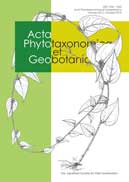Volume 67, Issue 1
Displaying 1-8 of 8 articles from this issue
- |<
- <
- 1
- >
- >|
-
Article type: Article
2016 Volume 67 Issue 1 Pages 1-16
Published: February 29, 2016
Released on J-STAGE: March 21, 2017
Download PDF (860K) -
Article type: Article
2016 Volume 67 Issue 1 Pages 17-27
Published: February 29, 2016
Released on J-STAGE: March 21, 2017
Download PDF (33060K) -
Article type: Article
2016 Volume 67 Issue 1 Pages 29-36
Published: February 29, 2016
Released on J-STAGE: March 21, 2017
Download PDF (2917K) -
Article type: Article
2016 Volume 67 Issue 1 Pages 37-45
Published: February 29, 2016
Released on J-STAGE: March 21, 2017
Download PDF (14598K) -
Article type: Article
2016 Volume 67 Issue 1 Pages 47-53
Published: February 29, 2016
Released on J-STAGE: March 21, 2017
Download PDF (7508K) -
Article type: Article
2016 Volume 67 Issue 1 Pages 55-59
Published: February 29, 2016
Released on J-STAGE: March 21, 2017
Download PDF (15176K) -
Article type: Article
2016 Volume 67 Issue 1 Pages 61-66
Published: February 29, 2016
Released on J-STAGE: March 21, 2017
Download PDF (24744K) -
Article type: Index
2016 Volume 67 Issue 1 Pages 67-
Published: February 29, 2016
Released on J-STAGE: March 24, 2017
Download PDF (18K)
- |<
- <
- 1
- >
- >|
